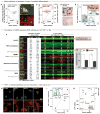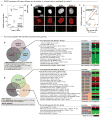Nuclear lamin-A scales with tissue stiffness and enhances matrix-directed differentiation
- PMID: 23990565
- PMCID: PMC3976548
- DOI: 10.1126/science.1240104
Nuclear lamin-A scales with tissue stiffness and enhances matrix-directed differentiation
Abstract
Tissues can be soft like fat, which bears little stress, or stiff like bone, which sustains high stress, but whether there is a systematic relationship between tissue mechanics and differentiation is unknown. Here, proteomics analyses revealed that levels of the nucleoskeletal protein lamin-A scaled with tissue elasticity, E, as did levels of collagens in the extracellular matrix that determine E. Stem cell differentiation into fat on soft matrix was enhanced by low lamin-A levels, whereas differentiation into bone on stiff matrix was enhanced by high lamin-A levels. Matrix stiffness directly influenced lamin-A protein levels, and, although lamin-A transcription was regulated by the vitamin A/retinoic acid (RA) pathway with broad roles in development, nuclear entry of RA receptors was modulated by lamin-A protein. Tissue stiffness and stress thus increase lamin-A levels, which stabilize the nucleus while also contributing to lineage determination.
Figures








Comment in
-
Cell biology. Strength under tension.Science. 2013 Aug 30;341(6149):965-6. doi: 10.1126/science.1243643. Science. 2013. PMID: 23990548 No abstract available.
-
Mechanotransduction: Lamin A for tension relief.Nat Rev Mol Cell Biol. 2013 Oct;14(10):610. doi: 10.1038/nrm3670. Nat Rev Mol Cell Biol. 2013. PMID: 24061223 No abstract available.
-
Label-free mass spectrometry exploits dozens of detected peptides to quantify lamins in wildtype and knockdown cells.Nucleus. 2013 Nov-Dec;4(6):450-9. doi: 10.4161/nucl.27413. Epub 2013 Dec 6. Nucleus. 2013. PMID: 24448480 Free PMC article.
References
-
- Chen BPC, et al. DNA microarray analysis of gene expression in endothelial cells in response to 24-h shear stress. Physiol Genomics. 2001;7:55–63. - PubMed
Publication types
MeSH terms
Substances
Grants and funding
- P30 DK090969/DK/NIDDK NIH HHS/United States
- P30 CA010815/CA/NCI NIH HHS/United States
- P01 DK032094/DK/NIDDK NIH HHS/United States
- 8UL1TR000003/TR/NCATS NIH HHS/United States
- UL1 TR000003/TR/NCATS NIH HHS/United States
- P30-DK090969/DK/NIDDK NIH HHS/United States
- P01DK032094/DK/NIDDK NIH HHS/United States
- CA010815/CA/NCI NIH HHS/United States
- R01 HL038794/HL/NHLBI NIH HHS/United States
- R01HL062352/HL/NHLBI NIH HHS/United States
- HL038794/HL/NHLBI NIH HHS/United States
- R01 HL062352/HL/NHLBI NIH HHS/United States
- R01 EB007049/EB/NIBIB NIH HHS/United States
- R01EB007049/EB/NIBIB NIH HHS/United States
LinkOut - more resources
Full Text Sources
Other Literature Sources
Molecular Biology Databases

